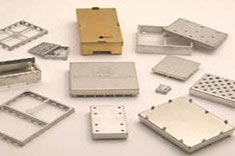EMI Shielding Products
- Custom Gasket Fabrication
- Connector Gaskets
- Bonded O Ring
- Custom Gaskets
- Conduct-O-Knit Knitted Wire Mesh
- Conduct-O-Seal Combo Gasket
- Conduct-O-Elastomer
- Conduct-O-Seal Oriented Wire in Silicone Gasket Material
- Conduct-O-Mesh Tape
- Conduct-O-Foam
- Conduct-O-Bond
- Optical Filters For Electronic Displays
- Shielded Vent Panels
- ESC Board Level Shielding
- 300 Series
How to Protect Against Narrow and Broadband EMI?
 EMI, or electromagnetic interference, is an inescapable problem of our modern connected world. Even before everyone had a smartphone, EMI was still an issue. The two main types of EMI include broadband and narrowband. Narrowband EMI occurs from TVs, mobile phones, and radios over a discrete frequency. Narrowband EMI causes signals to cross, which results in malfunctioning devices. Often, narrowband EMI disrupts performance which is an inconvenience: it doesn’t permanently damage equipment.
EMI, or electromagnetic interference, is an inescapable problem of our modern connected world. Even before everyone had a smartphone, EMI was still an issue. The two main types of EMI include broadband and narrowband. Narrowband EMI occurs from TVs, mobile phones, and radios over a discrete frequency. Narrowband EMI causes signals to cross, which results in malfunctioning devices. Often, narrowband EMI disrupts performance which is an inconvenience: it doesn’t permanently damage equipment.
On the other hand, Broadband EMI is much more likely to damage devices permanently. It happens over a broad spectrum that occupies an ample space of the electromagnetic spectrum. Broadband EMI is experienced most when devices are using digital data links.
EMI shielding is one of the best options manufacturers and designers have to protect devices from both types of EMI. Shielding works by preventing EMI from entering systems and preventing EMI from exiting. EMI is created from natural occurrences like the sun, but individual electronic devices often cause daily EMI. Computers and cars consist of multiple electrical components housed within a single unit. EMI shielding protects each device from outside interference and interferes with nearby electronics.
Without EMI shielding, it would be difficult for modern electronics to function as seamlessly and efficiently as they currently do. As more and more traditional devices become smart, meaning that chips and circuitry are added, EMI protection will become much more critical. If you haven’t thought in depth about how EMI affects your devices, it is time to reach out to our team to discuss designing fully protected devices.



